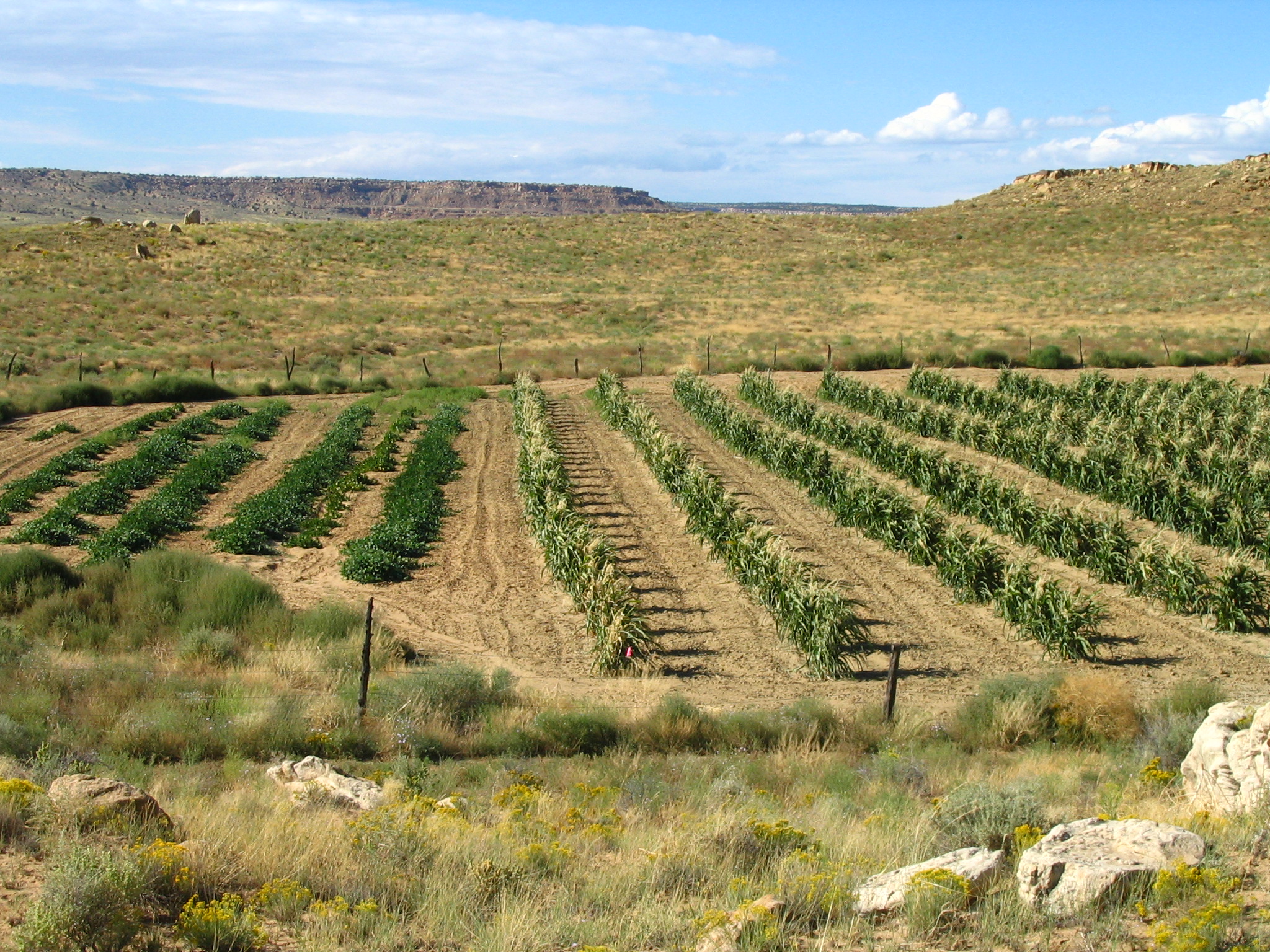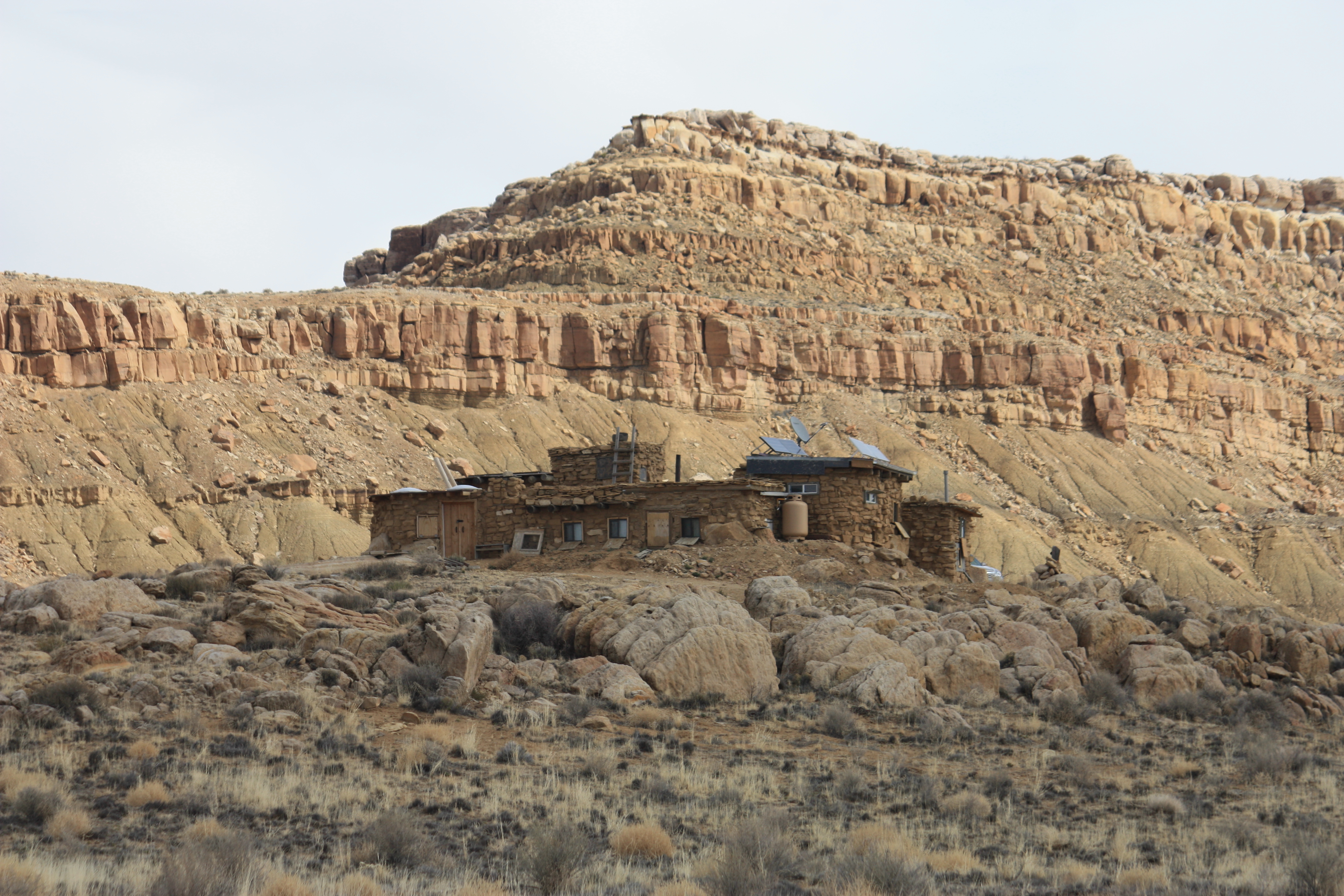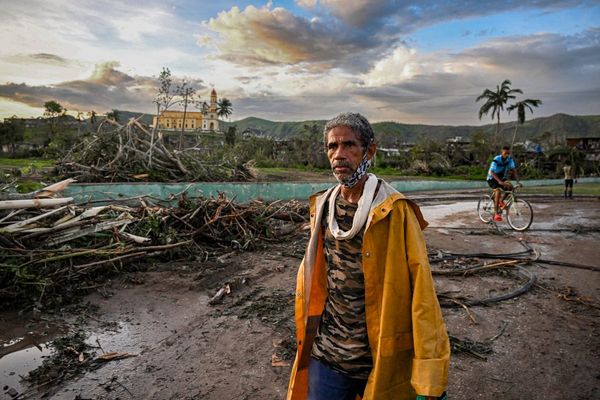
Listen to this story:
Arizona, United States – Michael Kotutwa Johnson scans the barren landscape and wonders if he’ll get a crop this year.
It is March and the Hopi reservation, which stretches across high plateaux in northeastern Arizona, appears as a patchwork of varying shades of brown: The mesas – deep bronze in the morning sun – stand stately over beige houses and the light tans of sand-covered fields, shrubs and grasses. Dryness reigns. Within hours of arriving on the reservation, hungry winds suck the moisture from mouths, skin and eyes, leaving only grainy dust in their wake.
It is hard to imagine plants, or any life, surviving and thriving in this water-starved scene, and yet for millennia, maybe more, Hopi farmers have grown corn, beans and squash in their fields, feeding their families and keeping their communities strong and healthy.
The Hopis are one of the oldest living cultures in documented history, with a past stretching back thousands of years. This Native American tribe now lives on the 1.5 million acres (607,000 hectares) of its reservation in Arizona, which comprises only a small portion of its traditional lands. The Hopis live primarily in villages on high, arid mesas that receive less than 10 inches of rain and snow each year. But born farmers, they’ve learned how to grow crops in this unforgiving environment.
“Hopi farming is a testament to our faith,” says Johnson, a Hopi farmer with a solid frame and easy smile, who sports a Carhartt cap over his salt-and-pepper ponytail.
According to their origin stories, when the Hopi people first emerged into this world, they met with Màasaw, guardian and caretaker of the Earth, who granted them a gourd filled with water, a planting stick, and corn seeds – all they needed to grow food. But to survive, Màasaw said, they would need one more vital ingredient: faith – faith in everything they do. For the Hopi, that meant always planting their corn and farming, whatever the obstacles.

For centuries, the Hopi have survived the full gamut of environmental challenges and the effects of colonisation, keeping their traditions and stewardship practices alive. But in the last few decades many Hopi have stopped farming and producing food with devastating effects on the tribe’s health: By the early 2000s, a high proportion of the formerly lean Hopi were obese and nearly a fifth had high blood pressure or diabetes according to an assessment by the Natwami Coalition, an affiliation of Hopi organisations dedicated to preserving Hopi farming traditions and strengthening the local food system. Now, instead of growing their food, many Hopi drive a four-hour round trip to supermarkets off the reservation and pay a premium for gas and groceries.
There are myriad reasons why the Hopi are farming less, ranging from lack of financial support to the frequent drought caused by climate change. But Johnson embodies the Hopi way of patiently and methodically looking for solutions. He is only focused on finding a path that will bring the Hopi back to farming and reclaiming their food sovereignty and health.
It is a quest that has taken him away from his own farm for lengths at a time, and engaged him in the realms of science, policy and outreach. But he sees those steps as just another way he is called to rise to Màasaw’s challenge. “We’re a faith-based society,” Johnson says. “Everything we do, we’re supposed to have faith behind.”
Born to farm
When a Hopi baby is born, relatives place a perfect ear of white corn, a “Corn Mother”, beside the infant. Then, two weeks later, a paternal aunt puts a small piece of sweet corn pudding in the baby’s mouth and raises them to the sun. “It’s to remind them where they’re from, and ground them in our ways,” says Johnson.
For the Hopi, those “ways” – their culture, lifestyle, religion and philosophy on life – are all wrapped up in farming and caring for the land, and there is no separation between their agricultural system and their spiritual beliefs.
“It is ingrained in us that we were destined to be in this environment and be farmers,” says Susan Sekaquaptewa, a member of the Hopi tribe and a certified organic gardener, seed-saver and food preserver, and founder of the Hopi Food Co-op, a community-owned group that provides access to local food sources as well as sharing knowledge of gardening and food preservation. “We were brought into this world with a responsibility to steward the earth and it’s a beautiful, powerful purpose that we have.”

Men introduce young boys to dryland farming early on; Johnson began working in the fields at the age of eight. That summer, his parents, who lived and worked off the reservation, left him with his grandfather on the family farm. Johnson’s grandfather came from a long line of Hopi farmers, stretching back for more than a hundred generations, and when Johnson complained that there was no TV and he was bored, his grandfather knew the solution. The next day, he woke Johnson up at 5:30am.
“We hoed fields and fixed fences all day and I never complained about being bored again,” says Johnson with his characteristic wry humour.
Johnson became acclimatised to the work and began to enjoy it; from then onward, he spent his summers helping his grandfather. Eventually, with farming in his blood and soul, he went to Cornell University in Ithaca, New York, where he learned about conventional agriculture, and it was there that he realised just how special his ancestors’ legacies were.
An intimate relationship
On a listless day in Cornell, where the sun barely made an entrance and endless drizzle spattered the window panes, Johnson sat in a lecture room and listened to a professor explain how corn needed 33 inches of rain to grow. As someone who had already raised thousands of ears of corn, without irrigation, where the annual rainfall was only 6-10 inches a year, Johnson just laughed. Johnson laughs frequently, a strong and loud cackle that defies doubts or worries, but the incident got him thinking: What was it that the Hopi did differently, and what could be learned from them?
Each spring, after the winter snows have long melted, the Hopi planting season starts. Johnson, like other Hopi farmers and his ancestors before him, patiently clears away weeds, brushes off sand and digs holes with a Soya – a Hopi wooden planting stick. At Cornell, Johnson learned that conventional farming techniques recommend setting corn at depths of an inch, but Hopi farmers will dig down as far from 6 to 18 inches to reach the moist soil, below the surface. Then he’ll place 10 to 20 corn kernels in each hole, move another three paces down the row, and repeat the process.

For 2000 years, his ancestors have tried and tested techniques to make the most of the winter snow and summer rains, and to protect their harvest from harsh winds, bugs and crows. The Hopi learned how to plant on areas close to washes or on alluvial flood plains, where telltale weeds like rabbitbrush hinted at damper soil below. And after years of trial and error, the Hopi use certain fauna they see each spring to determine the soil moisture and how deep, and far apart, they need to plant.
Once the corn starts to reach above the ground, the farmers thin out the shorter stalks, leaving only the sturdiest few in each clump. It’s a process that, over the centuries, has favoured strong, drought-resistant seeds.
Caring for a new crop requires daily attention, an intimate relationship between the farmer and his plants. In the summers, Johnson patrols the fields, often talking and singing to his plants, encouraging them to grow and be strong. He inspects each plant gently for bugs and, when he finds them, squishes each one with his fingers as Hopi dryland farmers do not use fertilisers or insecticides. “Our band aid out here is nature. It’s not chemicals,” Johnson says. “We’re living with this environment, not manipulating it or taking advantage of it.”
Johnson estimates that, throughout the year, from taking the seeds out of storage, to planting, to thinning and tending, and then harvesting his crops, he will touch his corn seven or eight times.

To the Hopi, plants aren’t just food, they are part of the family, Sekaquaptewa says. “Farmers go talk to them and acknowledge them as part of our extended family.”
It is the caring for the land that has allowed the Hopi to endure, Johnson says. Their agriculture is geared towards survival, for their own families and future generations, rather than for economic gain. “We haven’t exhausted the environment, and haven’t hurt the environment. And still we’ve been able to feed ourselves.”
Consequently, Hopi farming is sustainable, conserves biodiversity and protects the land.
While Native American farming practices vary in each location, the principles of responsibility and stewardship are common to all, says Toni Stanger-McLaughlin, a citizen of the Colville Confederated Tribes, and chief executive officer of the Native American Agriculture Fund. “In our creation stories, a common theme is that animals or plants give themselves to the people in a respectful manner,” says Stanger-McLaughlin. “And in turn we care for them and continue their existence into the future by cultivating gentle practices, which protect their ecosystems.”
‘They are forgetting who they are’
During the Great Depression of the 1930s, the Hopi remained relatively unscathed as then they produced all their own food. But it was a different story when the COVID-19 pandemic hit. With travel restricted, many Hopi had to stand in line for several hours to receive food distributions.
“The pandemic really showed us the need to go back to our teachings and learn how to have food security again,” says Kyle Nutumya, programme director for the Natwami Coalition.
In 2004, a Natwami Coalition assessment of Hopi food, health and farming practices revealed that, in the mid-2000s, less than a third of the interviewees still farmed. And the costs of buying food were high.

Few shops exist on the reservation and to buy a wide selection of groceries, tribal members drive two hours to the border towns of Winslow or Flagstaff – a half-day round trip. The assessment revealed that the Hopi were spending nearly $7m a year to transport food to their communities and effectively paid a 66 percent premium on food purchases. On average, each Hopi shopper spent an extra $2,000 a year bringing food into their household.
“When I first saw those numbers, I nearly fell out of my chair,” Sekaquaptewa says. “We are so far off the track of food sustainability.”
Not farming, losing their independence, and losing their connection with their traditional practices has taken a toll on the Hopi’s physical health, as well as on their psychological health. Along with lack of jobs, these are the root causes behind substance abuse problems in Native communities, Johnson says. “They are forgetting who they are, and they go to find something to fill those voids that would have otherwise been filled by hunting or by raising plants.”
Lack of recognition
The biggest barriers to Hopi farming come from lack of support from the outside world, even if that support means just allowing the Hopi to adapt in their own way, Johnson says. Despite nearly 50 years of farming his fields, building a house high on a hill – one stone slab at a time – and his ancestors’ long history of tending to, caring for and protecting the environment, one fact stands stark: the Hopi don’t own their lands.
Like other Native American tribes, the Hopi Tribe is in a trust relationship with the federal government: The United States holds legal title to reservation lands and the tribe holds the “beneficial title”. They can live on the reservation, but they don’t have absolute title to their own lands. This one fundamental fact leads to many of the barriers facing Hopi farmers today, Johnson says. While he laughs and jokes easily, when it comes to talking about the rights of his people, Johnson becomes serious. The Hopi cannot make decisions about their lands or govern in a way that adapts to changing circumstances without first gaining approval from the federal government, he says.
In the 2004 assessment, the respondents who’d given up farming were 10 times more likely to cite access to land as the cause than any other factor. All the community members cited lack of water and access to productive lands as the chief barriers to farming.
Moreover, Native American farmers have historically lacked access to the financial support and subsidies that conventional farmers received. In 2010, the Obama Administration agreed to pay up to $760m to compensate Native American farmers and ranchers who were denied low-interest loans from the United States Department of Agriculture, while such loans were granted to white farmers and ranchers.

Since that date, however, there have still been many financial barriers facing Indigenous farmers, including the Hopi, in the US. A 2021 study revealed that the Hopi, like most Native American tribes, weren’t benefitting from the payment for ecosystems services programmes (PES) that have become popular worldwide to address goals such as biodiversity conservation, climate change and economic development.
The study authors concluded that land tenure – who is said to “hold” or have rights to the land – is the biggest barrier facing Indigenous communities in accessing such PES programmes. When agencies such as the Natural Resources Conservation Services want to collaborate with tribal members, they need to sign written agreements with tribal members who often hold land in collective and must prove they are the landowners.
As each tribal member has some stake in the land, an agreement requires multiple signatures, leading to lengthy delays. Such agencies are geared towards working with private property owners, “And that model doesn’t quite fit here,” Johnson says. “Because a lot of the time, at least in the case of the Hopi, the tribal government doesn’t have jurisdiction over our clan lands, or village lands.”
Some of the challenges are bureaucratic: The sheer amount of paperwork and logistics involved in getting some agriculture resource management plans up and running, without technical assistance, is prohibitive, Johnson says. But also damaging is the general lack of recognition by policymakers, authorities and scientists, as to the value of Indigenous agricultural knowledge and how Native American farming practices protect and sustain the land.
“They’ve been there a long, long, long way before us, and they’ve been farming in the desert for way longer than us,” says Trent Teegerstrom, a programmes specialist in agricultural and resource economics at the University of Arizona. “So not recognising their practices? That’s a big thing.”
Walking in two worlds
Once he had completed his degree, Johnson returned to the Hopi reservation and continued to farm using the timeworn traditional techniques he had learned. The Hopi believe that they are like corn, and Johnson jokes that he felt that resemblance strongly when he returned from Cornell. Fresh corn emerges to a new world after weeks of being kept in the dark and Johnson felt revitalised to be outside in the light, bright sunshine after his years in a busy city. The steady routine of farming also gave him time to ponder and think about his future.
“As I get older, the more I love it, and the more educated I get, the more I realise I have a responsibility to help people,” Johnson says. Since he didn’t have children – aside from his corn – Johnson saw that he needed to help his people; he did this through Hopi farming, by getting a seat at the policy-making table, and deciding to study for a PhD in natural resources at the University of Arizona in Tucson, a seven-hour drive away.
“All I was doing was learning to speak in a new language so that people on the other side of the fence could understand where I am coming from,” Johnson says. “And at the same time take some of the goodness I see in science and bring it back home.” His research focused on the barriers preventing Native American farmers from participating in federal conservation programmes and how to address them.
Johnson applied the same dogged determination, coupled with patience and a healthy dose of enthusiasm, to studying that he had learned from farming. During the 12 years it took him to get his PhD – while he continued to farm and build new additions to his stone house – he drew admiration from his academic colleagues and co-workers who witnessed firsthand his dedication to fighting for the rights of Indigenous Peoples and the land they lived on. And when he defended his dissertation in 2019, the turnout of people who’d been touched by his passion for his work was so huge that it was standing room only.

Johnson wasted no time in his defence as he described the centuries of experience gleaned by the Hopi in growing crops and protecting the land. He handed round ears of the characteristic dark blue Hopi corn and let attendees know that they were holding life, history and resilience in their hands, and he encouraged everyone to take, and plant, a few seeds of their own. “There was just amazing dialogue and energy in that room,” says Dr Karletta Chief, director of the university’s Indigenous Resilience Center (IRC).
While his presentation proudly trumped the wisdom of traditional land stewardship, Johnson’s deep bass-baritone voice drummed home the origins of the barriers threatening the continuity of such practices: colonialism and insufficient land rights. It is a message he has carried forward in the years since.
Off the reservation, Johnson’s mission is to bring recognition to Indigenous agricultural knowledge and how using traditional practices can help Natives and non-Natives alike steward the land, protect biodiversity and adapt to environmental fluctuations. He frequently quotes the statistic that Indigenous Peoples – although just 5 percent of the world’s population – protect 80 percent of global biodiversity on 25 percent of the land; his call to action is merely to support and reinforce their existing practices and not to reinvent the wheel.
“Conservation is a hook that can bring recognition and positiveness towards the land management practices that we’ve been doing since time immemorial,” Johnson says. “And by having the conservation community understand what we’re doing, we’ll have more political muscle to make some positive changes.”
Learning from time-tested experience
Recognising and learning from Indigenous knowledge is particularly important when it comes to adapting to climate change, Johnson says. Native Americans have centuries, if not millennia, of experience adapting to a changing environment and have developed flexible, resilient systems for growing and storing food.
By learning over time to remember to grow enough crops to last three to five years – a “no rainy day” reserve – the Hopi have a built-in insurance system. And even if the year looks too dry to yield a crop, Johnson will still plant some of his varieties of corn. “Unless you do that these plants won’t adapt, they won’t change,” he says. “Those little seedlings know how to do that while we as human beings are forgetting how to do that.”

Adapting to climate change is another reason why the Hopi should continue to farm, whatever the circumstances, Johnson says. Doing so will shore up vital supplies and keep the plants adapting to the hotter, drier climate. “We just have to have faith and keep farming. Just giving up – where is the happiness in that? We’re supposed to be farmers.”
Johnson hopes his efforts off the reservation will reverberate back to his homelands. He wants to create policies and funding that will bring more Hopi back to farming and he has a vision to create a self-sustaining economy that will benefit the tribe monetarily and create jobs. “We need to get Indian country to be fully sovereign, as far as food is concerned,” he says. “So, let us lead the way out.”
Johnson never expected to have a PhD or be involved in policy, but now his long-term goal is to use his training in science and policy, and his experience as an Indigenous farmer, to help Native American agriculture thrive and foster the independence, health and sense of identity that comes with it. “Indigenous agriculture uses the environment to its full potential, and it gives us all these gifts back,” Johnson says. “My position is to show that we can still practice this way.”
Gaining momentum
At the first day of the Tribal Nations Summit, a conference designed to facilitate conversations between the Federal Government and Native American Tribes and Alaska Natives, in November 2021, the White House released a memorandum stating the Administration’s commitment to incorporating traditional Indigenous knowledge into the scientific, social and economic advancement of the US. A flurry of memos followed, geared towards including Native Americans, their culture and knowledge in policy decisions.
“It’s a beautiful start,” but now the real work begins, Johnson says. There are new challenges afoot to integrating Indigenous agricultural knowledge into federal programmes, from taking care to protect that knowledge to translating it into a way that it can be helpful to non-Indigenous farmers.
Now that policymakers are finally recognising Indigenous knowledge, Johnson is focusing on making sure that the memos serve Indian Country. To that end, he is starting a new position in June 2022 at the IRC in Tucson.
“A key goal of the Center is to create partnerships with Native Nations and help them build resilience in the face of environmental challenges, such as climate change or contamination of water supplies,” Chief says. “And to do that in a way that respects their knowledge, protects their Indigenous data sovereignty, and prioritises the tribes’ needs and wants.”

For Johnson, he has found his academic home, or farm: a place where he can plant seeds, nurture relationships, and use both traditional knowledge and Western science to help Indigenous agriculture thrive in the coming decades.
Like his ancestors before him, he is focused on using ingenuity to find solutions, especially when it comes to climate change. “We should not be trying to traumatise people to make them change, or playing to their fears,” he says. “We should be giving them hope.”
In the coming months he’ll be planting and tending to this year’s corn, beans and melon.
Scanning the brown landscape, in his mind’s eye, he can already see the fields ablaze with green leaves of young corn, reaching upward towards the sunshine. There is a constant building up in farming, but its slow progress and patience is key, Johnson says. “Then it’s so exciting when you see the first plant, like a little newborn baby, coming up from the ground.”
But, for now, all he has is his faith. He kicks a layer of sand off the beige soil, and his dog, Soya, named after the Hopi planting stick, follows suit. An inch down from the surface, the soil turns tan from moisture. Soya digs deeper and the soil turns fawn. An inch further and it is the colour of copper.
Johnson smiles. It is going to be a good year.
Travel for this this feature was funded by an Institute for Journalism & Natural Resources Field Reporting Grant.







